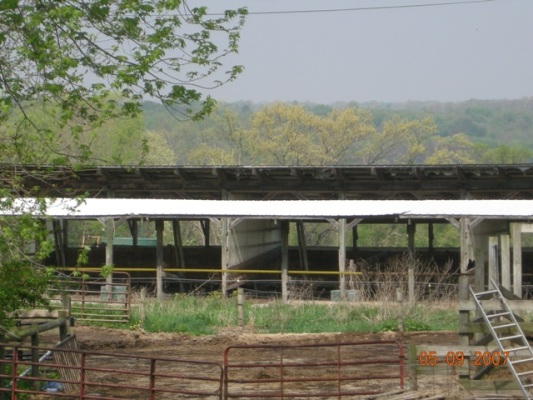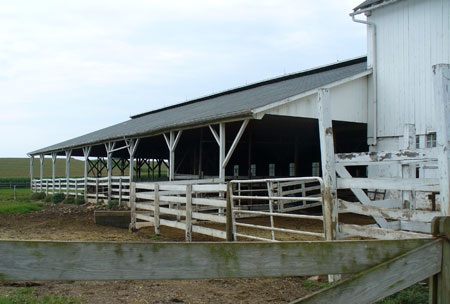Free Stall Barn
In the post World War II period, a fundamental change occurred in thinking about animal shelter on the farm. The free stall barn (also called a Loafing Shed, Pen Barn, Loose Housing, or Open Stall Barn) became more highly recommended by agricultural engineers and animal researchers. Farmers began to use the system to replace the stall-and-stanchion type of arrangement. When not being milked, cows roamed freely in a large open space with dirt floor and ready access to hay or silage. This space sometimes had minimal walls, admitting plenty of air and sunlight. As long as cows were protected from winds, they were not bothered even by very low winter temperatures. At milking time, the cows were trained to walk into a milking parlor, where they ate feed concentrates while being milked, then proceeded straight ahead back into the pen or pasture. This saved on labor costs in feeding (the animals fed themselves in the pen, and were fed concentrates simultaneously with milking) and stable cleaning, and it saved construction costs because the pen barn lacked full walls, expensive stanchions, and full concrete floors, and was less well insulated.
The free stall barn system incorporated a milking parlor, and often the milk house then adjoined the parlor. Very often, the free stall barn was made of pole construction, also an innovation in the postwar period. It did not have a hay loft. Another important advantage of the free stall system was in improved animal health and productivity. A famous University of Wisconsin study published in 1953 offered powerful evidence that dairy animals had fewer injuries and infections, and actually gave more milk under the free stall regime. The free stall barn can be found throughout the state. Likely few are more than 50 years old. Modern versions are often very large.

Free Stall Barn, Mercer County, mid-twentieth century

Free Stall Barn, Londonderry Township, Chester County, c. 1980.
(Site 029-LN-004)